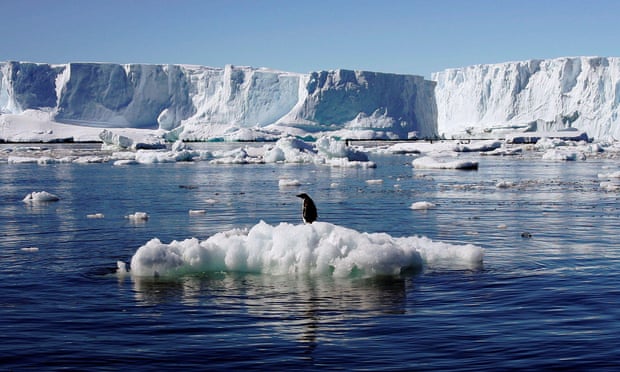Study finds ‘direct evidence’ of polar amplification on continent as scientists warn of implications of ice loss
Antarctica is likely warming at almost twice the rate of the rest of the world and faster than climate change models are predicting, with potentially far-reaching implications for global sea level rise, according to a scientific study.
Scientists analysed 78 Antarctic ice cores to recreate temperatures going back 1,000 years and found the warming across the continent was outside what could be expected from natural swings.
In West Antarctica, a region considered particularly vulnerable to warming with an ice sheet that could push up global sea levels by several metres if it collapsed, the study found warming at twice the rate suggested by climate models.
Climate scientists have long expected that polar regions would warm faster than the rest of the planet – a phenomenon known as polar amplification – and this has been seen in the Arctic.
Dr Mathieu Casado, of the Laboratoire des Science du Climat et de l’Environnement in France and lead author of the study, said they had found “direct evidence” that Antarctica was also now undergoing polar amplification.
“It is extremely concerning to see such significant warming in Antarctica, beyond natural variability,” he said.
Antarctica is the size of the continental US and Mexico combined, but has only 23 permanent weather stations and only three of these are away from the coast.
Casado and colleagues examined 78 Antarctic ice cores that hold a record of temperature and then compared those temperatures to climate models and observations.
The research, published in the journal Nature Climate Change, found Antarctica was warming at a rate of between 0.22C and 0.32C per decade, compared to 0.18C per decade predicted by climate models.
Part of the warming in Antarctica is likely being masked by a change in a pattern of winds – also thought to be linked to global heating and the loss of ozone over the continent – that has tended to reduce temperatures.
Dr Sarah Jackson, an ice core expert at the Australian National University, who was not involved in the study, said the findings were “deeply concerning”.
“All our projections for future sea level rise use these low rates of warming. Our models might be underestimating the loss of ice that we might get,” she said.
Dr Danielle Udy, a climate scientist and ice core expert at the University of Tasmania, who was not involved in the paper, said the research was timely “given the extreme events we have been seeing in Antarctica”.
Scientists are scrambling to understand why Antarctic sea ice has been at record low levels over the last two years, with some suggesting global heating could now be affecting the region.
Thousands of emperor penguin chicks likely died in late 2022 after the usually stable sea ice supporting colonies in West Antarctica melted.
Dr Kyle Clem, a scientist at Victoria University of Wellington in New Zealand, has studied recent record high temperatures at one weather station at the south pole.
Clem said Antarctica’s climate was subject to large natural swings, but Casado’s study had shown “a detectable change in Antarctic climate and an emergence of anthropogenic polar amplification”.
He said the results would be crucial for understanding the future of the continent “as greenhouse gases continue to increase”.
“The implications of this study are of particular importance for considering future changes in Antarctic sea ice, terrestrial and marine ecosystems, and potentially even sea level rise,” Clem said.
“If anthropogenic polar amplification is already occurring in the Antarctic that exceeds that simulated by climate models, then future warming will likely be greater than that currently projected by climate models.”
A warming Antarctic, he said, would also likely lead to further losses of sea ice that would have implications for “ocean warming, global ocean circulation, and marine ecosystems”.
“As far as sea level rise, ocean warming is already melting protective ice shelves in West Antarctica and causing the West Antarctic ice sheet to retreat.”
Greater warming could also lead to more melting of coastal ice shelves that protect glaciers.
“This has already been seen on the Antarctic peninsula in recent decades, and it could become a more widespread occurrence around Antarctica sooner than anticipated in a more strongly warming Antarctic climate,” he said.
- Karlston and Adenman
-

 2
2



Recommended Comments
There are no comments to display.
Join the conversation
You can post now and register later. If you have an account, sign in now to post with your account.
Note: Your post will require moderator approval before it will be visible.